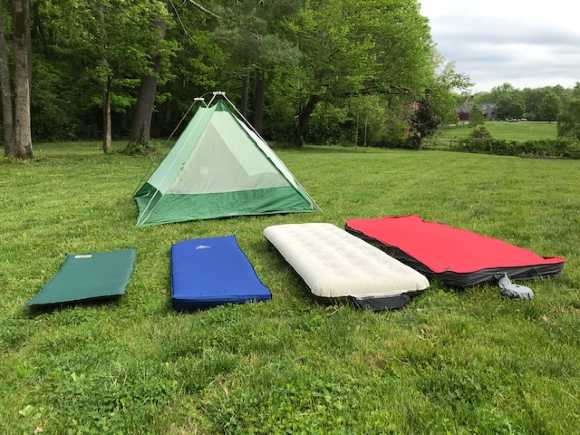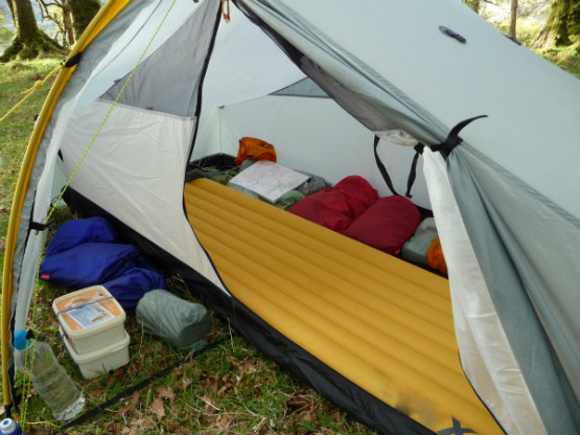If you’re new to the world of camping, it’s very likely that you’re clueless about the type of equipment you need to bring on your first camping trip. There are certain items you can get away with, and others that are absolutely necessary. But eventually, you’ll need to stick to a certain camping gear essential list if you want to camp safely and comfortably in the wilderness.
Just because you won’t be sleeping in your bed for a few nights, it doesn’t mean you can’t be comfortable. A camping mat, also known as a sleeping mat, is one of the most important pieces of camping gear you’ll need, yet sometimes you’ll hear that certain campers overlook this piece of equipment looking to save space in their backpacks.
The Different Types of Sleeping Mats
The right type of sleeping mat will shield you from the trail’s lumps and bumps and insulate you from the ground’s freezing temperatures, which can be far colder than the air you’re breathing. Sleeping mats are typically constructed in one of three ways: self-inflating, non-self-inflating, or closed cell foam mats. Each of these provides a unique method of trapping air and isolating the body from the ground, and each has its own set of advantages and disadvantages. When looking for a sleeping mat camping model, look for one that is lightweight, portable, and comfy.
If you’re going auto camping, you’re likely to have plenty of room in your trunk for thick, heavy, and comfy sleeping mats. However, when you’re hiking, canoeing or bike touring, you must consider the weight and packed size of the sleeping mat you’re going to carry. Choose a shorter length or mummy type of mat to minimize the weight as much as you can. Inflatable insulated cushions are also frequently available in lighter versions. Check the sleeping pad’s dimensions and make sure it can be rolled or folded into a shape that fits inside your backpack or pannier. Closed-cell foam pads can be carried securely on the outside of your pack, but self-inflating and inflatable pads should be carried inside your backpack to avoid ruptures.

Closed Cell Foam Mats
These mats, which are lightweight but take up more space than other choices, provide insulation through closed air pockets inside the foam substance. These trap air within the foam and keep you warm against the chilly ground. These foam mats will not collapse since they are built of closed air cells (no air can escape each cell). As a result, they are significantly stiffer and perhaps more painful to use. As a result, they will take up more room and must be rolled when stored.
Self-Inflating Mats
Self-inflating mats operate by absorbing air when the valve is open, causing the foam to expand. They are made internally of foam packed inside an airtight shell. Because of the kind of foam utilized (open cell), they are compressible, making them more comfortable and simpler to pack than closed-cell foam mats. The amount of foam utilized inside the mat determines the level of comfort and insulation provided, which typically results in a trade-off with weight and expense. Due to its lightweight but compressible nature, self-inflating mats are possibly the most popular among campers.
Non-Self-Inflating Mats
Non-self-inflating mats can be used to cover a broad variety of mats. In general, they all require manual inflation with a foot pump or just your mouth and typically come with a robust cover. The sort of insulation utilized inside is where they differ. There is the air alone mat that has no extra insulation, is lightweight, but offers very little insulation, making it best suited for summer use. And, the down and synthetic insulated sleeping mat camping option, which is significantly more successful at keeping you warm at night, as down is the best but most expensive alternative. They are often thicker and heavier.
Why Do You Need a Sleeping Mat for Camping?
There are many reasons why a sleeping pad is an essential camping gear item. A sleeping mat is almost as crucial as a sleeping bag because it is mostly what keeps you warm and away from the cold and hard ground. This, in conclusion, illustrates what sleeping mats are all about: the comfort and insulation they provide.

Comfort
Unless you are used to sleeping on the ground, you should always carry a sleeping mat when camping. If you don’t believe you need one, try sleeping on your floor in your house or outside in your backyard. It will get very uncomfortable after the first hour without a doubt. Remember that when you’re in the woods, the terrain will be uneven and often strewn with pebbles and roots. The sleeping pad acts as a cushion between you and whatever is “on the ground.” And, depending on the type of pad you’re going to use, the pad can often be a suitable alternative for a standard mattress. While it’s tempting to ignore “creature comforts” when camping, there’s no reason to torment yourself for eight hours by sleeping on something unpleasant.
Warmth
The most crucial advantage of a sleeping mat is the warmth it delivers. Many campers are unaware that sleeping mats are essential for keeping a camper warm at night. When someone sleeps, no matter how thick or bulky a sleeping bag is, the bottom of it loses all insulating effectiveness because the insulation is squashed beneath the weight of the camper. Because the insulation is practically non-existent, a camper that doesn’t use a sleeping mat is virtually sleeping on the freezing ground. This can be avoided by using a sleeping mat. The sleeping pad acts as an insulator between the camper and the chilly ground. In general, the thicker the pad, the more insulation it gives.
Even if sleeping on hard ground isn’t an issue for you, you’ll most certainly feel the chill of the woods even in the summer. This is due to conduction, which causes the earth to absorb your body heat. As a result, sleeping pads are even more vital in the winter. Some campers even use two sleeping mats at the same time.
